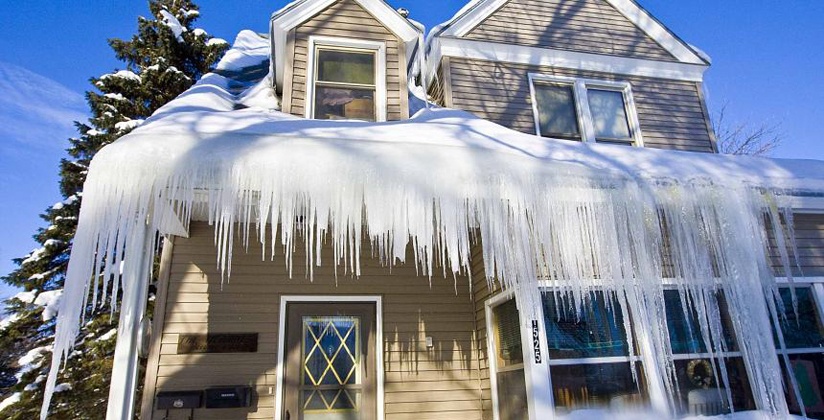Ice dams are a major cause of home damage during the snowy season in Connecticut. They are humps of ice that forms at the edge of a roof under certain wintertime conditions. They can dump gallons of water into your walls, through your ceilings, and onto your floors. Insulation, drywall, furnishings, window treatments can all be damaged or destroyed. In addition, gutters and downspouts can be at risk.
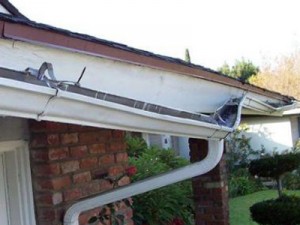
Prudent up front work will preclude ice dam damage. There are stop gap measures to be taken for those who have not done theup front preventive work - damage from ice dams is not a foregone conclusion.
What Causes Ice Dams?
Ice dams are usually caused by a combination of heavy snowfall, inadequate water-repellent protection and often, improper attic insulation or ventilation. The process of thawing and refreezing is what causes an ice dam. Water builds up, and finds its way into your home.
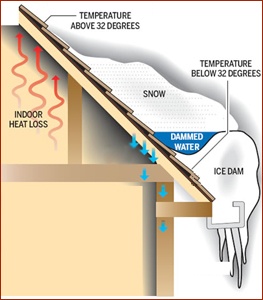
The flatter the pitch of the roof, the easier it is for an ice dam to get a grip. If snow and ice build up high enough in the gutters, they can provide a foundation for an ice dam. 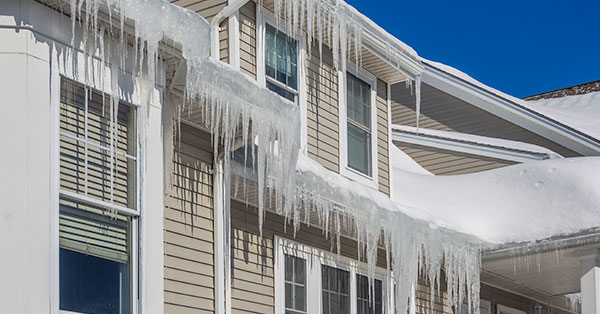
There are several things you can do to avoid getting an ice dam or to reduce the risk of damage after one has formed. A combination of better sealing, insulation, and venting in the attic and eaves helps, but will not solve the problem unless the water repellent barrier is also installed in the right places. Proper installation of ice and water shield is the only real cure.
What Damage do Ice Dams Cause?
If the ice dam breaks free, it can pull shingles and gutters off with it, and it can damage anything it falls on: whether that's cars, pets, people or your shrubs.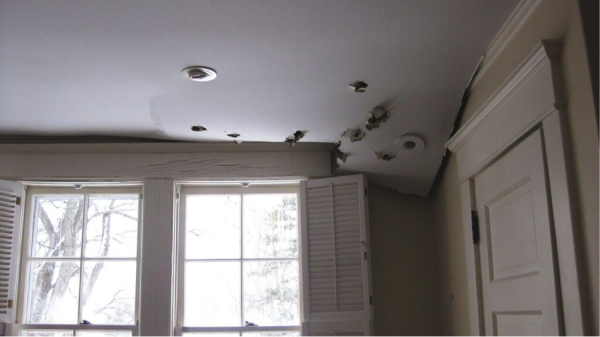
If the roof sheathing stays wet, it can form mildew and start to rot, and mold can develop within your home from all the moisture that comes in. Water can damage walls, hardwood floors and everything inside your home.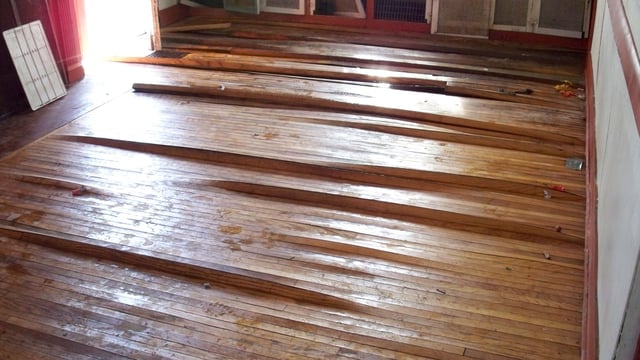
The Cure for Ice Dams
The underlying problem is that when water melts, it can run inside your home. So #1 - you need to make sure there is no where that water can go in. This means that you need to have ice and water shield applied generously.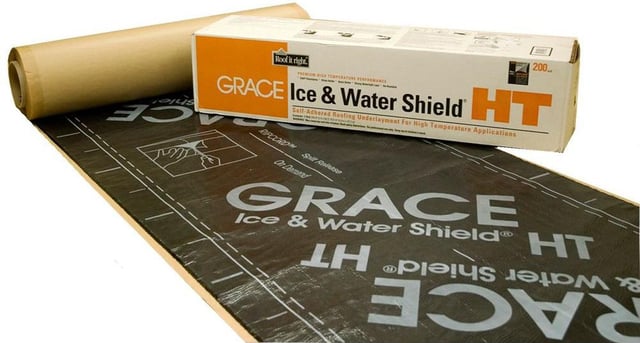
Secondly, keeping your roof cooler helps to minimize ice dams. A warm roof is caused by poor insulation and poor venting of the space under the roof.
The 4 Essentials for Preventing Ice Dam Damage
Over the years , we have found the following to be most effective actions we can take for our Clark Construction clients to preclude ice dam damage: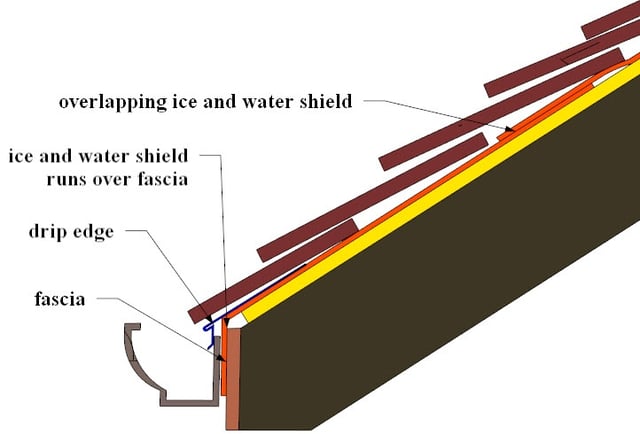
1. Install ice and water shield over the fascia and up onto the roof:
- Remove the gutters and roofing.
- Apply ice and water shield over the fascia and up onto the roof. Ice and water shield is 3' wide, so approx. 30" comes up onto the roof.
- Then apply an overlapping layer of ice and water shield, so that the water repellant material comes up between 5 to 5 1/2 ft. onto the roof. Many contractors install ice and water shield 3' up, without wrapping the fascia. That is NOT good enough. Water can get behind the drip edge and the fascia, and into your home.
- Lastly, reinstall the drip edge, roofing, and gutters.
- Where the roof intersects the side wall, install ice and water shield on the roof deck and up the siding a minimum of 18". 36" is preferred.
- Valleys need ice and water sheild too.
- For lower roof pitches, ice and water shield on the whole roof is advisable.
2. Seal all points where warm air leaks from the living space into the spaces immediately below the roof sheathing.
3. Insulate the living space well to prevent conduction and convection of heat through the ceiling.
4. Vent the space between the insulation and the roof sheathing, so any heat that does leak through is carried away. This Old House has a good article about how to make improvements to help keep your roof the same temperature as the eves.
Note that just doing the sealing, insulating and venting is NOT a cure. You need to do the water repellant membrane, and do it right, as noted above. The sealing, venting and insulation component of the ice dam cure will also cure a significant loss of heat from your home, saving you $$$. Plus your tighter home will feel more comfortable during these cold New England winters.
Dealing with Ice Dams
If you didn't do the preventive work, there are a few avenues of attack that can help reduce the probability of ice dams and their damage.
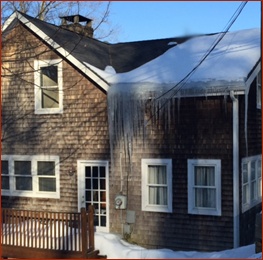
1. Get the snow off the roof.
Immediately after a snowstorm, you can scrape snow from the roof whenever it falls, using a snow roof rake from below or a broom or plastic shovel from above.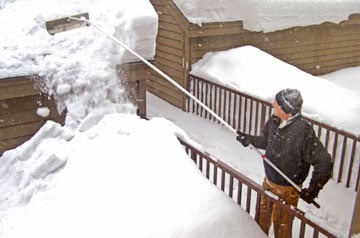 This is a temporary solution which treats the symptoms, not the underlying problem. Additionally, this solution has its own set of issues; removing snow from below can bury you in snow, while you can slip off the roof while shoveling.
This is a temporary solution which treats the symptoms, not the underlying problem. Additionally, this solution has its own set of issues; removing snow from below can bury you in snow, while you can slip off the roof while shoveling.
It's a great idea to get someone else to do this for you.
 Tips for roof rakes:
Tips for roof rakes:
- The rake should have small rollers, bumpers, or wheels near the blade of the rake. These are important because they keep the blade of the rake away from the surface of your roof.
- A roof rake with a slightly bent handle is more versatile and easier to use.
- Roof rake extensions allow you to reach the farthest parts of your roof.
- Plastic rakes are lighter to lift. If you prefer an aluminum rake, keep it away from power lines!
2. Get Rid of the Ice
1. Remove the ice dam by breaking it free in small chucks. Do NOT use an ax or other sharp tool! You’ll cut through the shingles. Instead, tap lightly with a blunt mallet. This is slow, dangerous work, so it's probably a good idea to hire someone experienced to do this. Even if done safely, the chunks of ice can take pieces of your shingles with them.
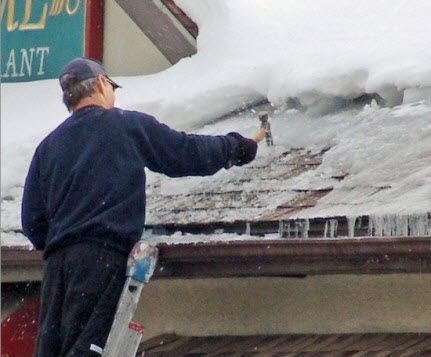
3. Clear out gutters and downspouts.
Again, this is ladder work and an easy way to damage either plastic or metal gutters and spouts.
4. Use Calcium Chloride
To deal with ice in the troughs, melt through the ice dam with calcium chloride ice melter. Do NOT use rock salt! It will leave a wake of destruction behind it; damaging paint, metals, and plants wherever the salty water drains.
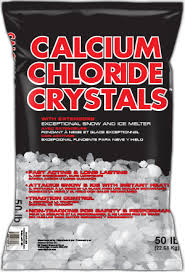
Hint: A good way to melt an ice dam and create a path for the backed up water to flow out is to make a tube from an old pair of panty hose. Fill it with calcium chloride, tie off the top, and lay it vertically across the ice dam. It will slowly melt its way down through the dam, clearing a path for the underlying water to flow freely.
5. Heat Wire
We typically recommend against heat wire. At its best, it's a bandaid. However, some houses have design flaws that cause them to be ice-dam magnets, where correcting the design flaw(s) is/are cost prohibitive. In that case, heat cable can help keep trouble spots clear of snow and ice and keep ice dams away.
But it's unlikely that you live in that house. So only try heat cable as a last resort.
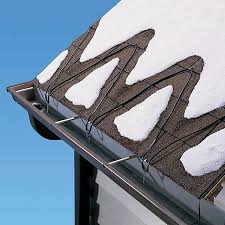 Why aren't we in favor of heat wire? A number of reasons:
Why aren't we in favor of heat wire? A number of reasons:
- it requires human intervention to turn it on and off,
- or sensors, (which can be unreliable)
- requires electric power to work,
- and snow that the heat wire melts can refreeze.
Plus, some homeowners forget to turn off the heat cable, leaving it accidentally powered on throughout the warmer months, wasting more energy and money, and causing the heat cable to wear out much faster.
Anything that melts snow on your roof can contribute to an ice dam. The cables will create lots of zig-zagging channels of melted snow across your roof. That melted snow is supposed to roll down the slope of your roof and onto the ground. But in many cases it ends up refreezing along the edge of your overhangs, or just above the heat cable.
So if you choose to use heat cables, please use them with caution. Use them prudently. Be sure to turn them off when they are not needed, and watch out for their contribution to ice damming.
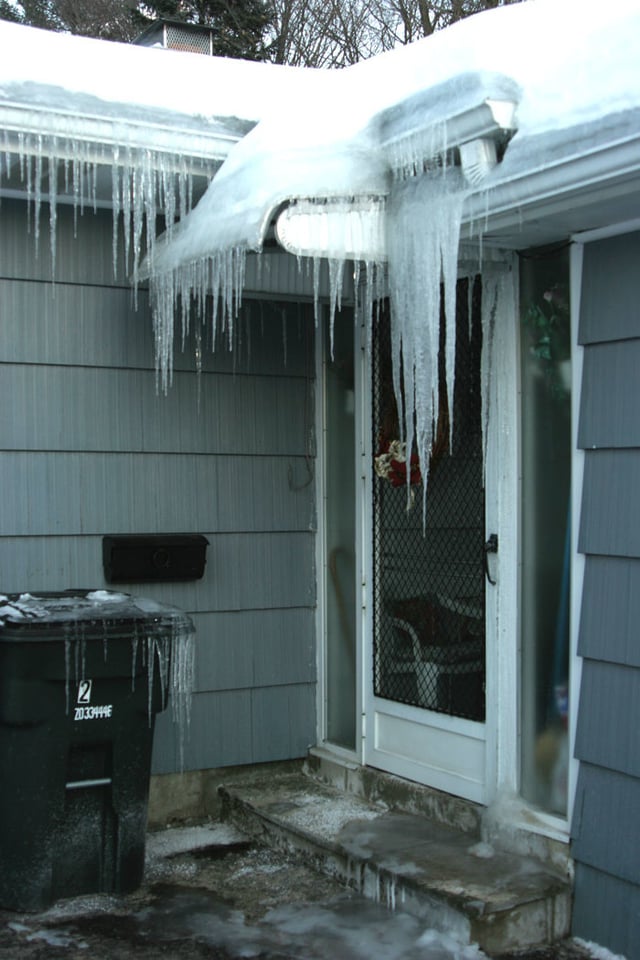
Conclusion:
Ice dams are one of those things that are really annoying, can cause a lot of damage, and can be avoided by properly maintaining your home in advance of the ice dam season.
WARNING! Performing ice dam removal is risking severe personal injury and damage to the roof if not done properly. Never walk on a snow covered roof and make sure if you are using a ladder that you follow the proper safety procedures. We highly suggest contacting professionals with the proper equipment and roofing experience to carry out this job.

 Back to All Posts
Back to All Posts